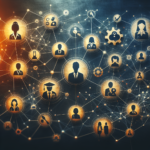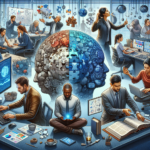
Read Someone’s Personality is the art and science of assessing an individual’s character traits, behaviors, and motivations within mere seconds of interaction. This practice is rooted in the understanding that each person exhibits distinct patterns in their demeanor, expressions, and body language that can provide insights into their underlying personality. The ability to quickly identify these traits can significantly enhance interpersonal relationships, improve communication, and foster effective social interactions.
In a world where first impressions are crucial, being able to read someone’s personality in a short time frame can prove invaluable. The ability to gauge another person’s disposition can inform approach strategies, allowing for more meaningful and successful engagements. For example, recognizing if an individual is introverted or extroverted can shape how one conducts a conversation, from the tone and content discussed to the level of engagement maintained. This is especially important in situations such as networking events, interviews, or any social gatherings where establishing rapport is essential.
Moreover, mastering the skill of personality reading can also aid in conflict resolution and team dynamics. Understanding whether a colleague is detail-oriented or big-picture focused can facilitate collaborations that respect each person’s strengths. Additionally, it promotes empathy, as recognizing diverse personality types fosters respect and acceptance of differences among individuals. By improving communication skills and recognizing varying perspectives, one can contribute positively to both personal and professional relationships.
As we delve deeper into this tutorial, you will discover step-by-step techniques designed to enhance your ability to read personalities effectively and intuitively. This practical knowledge will empower you to navigate social interactions with greater confidence and insight.

Personality assessment is grounded in a rich tapestry of psychological theories and frameworks that provide insight into human behavior and traits. One of the most widely recognized models in personality psychology is the Big Five Personality Traits, often referred to as OCEAN, which stands for Openness, Conscientiousness, Extraversion, Agreeableness, and Neuroticism. This model posits that these five dimensions encompass the broad domains of human personality, allowing for a structured and systematic approach to understanding individual differences.
The Big Five theory suggests that by analyzing an individual’s scores across these five dimensions, one can gain valuable insights into their personality profile. For instance, high levels of openness relate to curiosity and flexibility, while high conscientiousness is associated with diligence and reliability. Extraversion reflects sociability and assertiveness, whereas agreeableness indicates a proclivity for compassion and cooperativeness. Lastly, neuroticism refers to emotional stability and the propensity for negative emotions. Such frameworks offer practical tools for conducting rapid personality assessments in both professional and personal settings.
Another important aspect of personality assessment is the use of standardized measures and instruments, which have been developed based on extensive research and empirical evidence. These tools facilitate quick evaluations by providing structured questionnaires that can reveal a respondent’s personality traits within a short timeframe. This scientific approach enhances the accuracy of assessments and makes it easier for individuals to comprehend the nuances of different personalities in a brief interaction.
By employing these established personality models and assessment tools, one can engage in quick, insightful evaluations that are not only efficient but also rooted in psychological theory. Understanding the science behind personality assessments enriches our ability to interpret human behavior and improve interpersonal interactions, supporting the tutorial’s primary objective of enabling rapid assessments.
During the initial five seconds of an interaction, individuals can glean significant insights into a person’s personality through a variety of observational cues. Body language, facial expressions, posture, and micro-expressions serve as windows into the emotions and traits of the individual being observed. These cues can be crucial indicators, often revealing more than verbal communication.
Body language encompasses a wide range of movements and gestures that can signify a person’s feelings and attitudes. For instance, crossed arms may suggest defensiveness or discomfort, while open arms can indicate approachability and confidence. Additionally, the degree of eye contact is telling; someone who maintains steady eye contact is often perceived as trustworthy and engaged, while averting gaze may hint at shyness or insecurity.
Facial expressions provide another layer of personality insights. A genuine smile, typically characterized by the involvement of the eyes (often referred to as “smizing”), can imply friendliness and warmth. Conversely, a furrowed brow or clenched jaw might indicate stress or agitation. Understanding these nuances allows observers to engage with others more meaningfully.
Posture is yet another significant aspect to consider. An upright and open posture often communicates confidence, whereas slouched or closed-off stances may relate to lower self-esteem or disinterest. Micro-expressions, which are fleeting facial expressions that occur involuntarily, can reveal underlying emotions that a person may not consciously acknowledge. These brief cues can be elusive but highly informative, indicating a person’s true feelings even against their verbal statements.
In summary, the first five seconds of interaction are rich with observational cues. By paying close attention to body language, facial expressions, posture, and micro-expressions, one can develop a more nuanced understanding of another’s personality, enhancing interpersonal communication and relationships.

Non-verbal communication plays a pivotal role in understanding personality traits and interpersonal dynamics. It encompasses a range of expressions, including gestures, facial expressions, eye contact, and body language, all of which can provide profound insights into an individual’s thoughts and feelings. Recognizing these non-verbal cues allows one to decipher underlying messages that spoken words may not convey.
Gestures are among the most illustrative components of non-verbal communication. For instance, open-handed gestures often signify honesty and openness, while crossed arms may suggest defensiveness or resistance. Additionally, the frequency and intensity of hand movements can indicate excitement or engagement levels. Paying close attention to these gestures can enhance one’s ability to assess another person’s personality traits effectively.
Eye contact is another significant aspect of non-verbal communication, reflecting confidence and attentiveness. Steady eye contact typically indicates being comfortable and invested in the conversation, suggesting traits like trustworthiness and assertiveness. Conversely, a lack of eye contact may point to shyness, discomfort, or even deceit. Observing how an individual engages with others through eye contact can provide insights into their emotional state and willingness to connect.
Personal space is also critical in decoding personality. The distance people maintain during interactions can reveal whether they are open, comfortable, or anxious. Generally, individuals who respect personal space may be regarded as more cautious or reserved, whereas those who invade personal space could be perceived as more extroverted or aggressive. Understanding these spatial boundaries allows for a better grasp of relational dynamics, contributing to a more nuanced reading of personality.
In essence, decoding non-verbal communication enriches our understanding of others by revealing their confidence, openness, and emotional states through subtle cues that often go unnoticed.

Verbal communication plays a pivotal role in understanding personality traits quickly. The way an individual expresses themselves—encompassing their speech patterns, tone, and choice of words—can reveal a significant amount about their character within a brief interaction. When engaging in conversation, the first aspect to observe is speech patterns. Individuals who speak in a rapid or erratic manner may indicate traits associated with anxiety or excitement, while those with a slower, more deliberate pace might exhibit thoughtfulness or caution. Therefore, the speed at which someone communicates can serve as a vital clue in personality evaluation.
Moreover, tone is equally crucial in verbal interactions. A person’s vocal inflection can convey enthusiasm, confidence, or nervousness. For instance, a warm and inviting tone typically reflects an open and approachable personality, whereas a harsh or monotone voice may signal rigidity or aloofness. The emotional undertone behind the words often enhances the listener’s perception of the speaker, allowing for deeper insights into their underlying traits.
Additionally, word choice offers profound insights into an individual’s personality. Someone who frequently uses positive, action-oriented language might be perceived as optimistic and energetic. In contrast, negative or passive wording can suggest a more subdued or cynical outlook. Recognizing these linguistic tendencies helps decipher the dynamic nuances of interaction, highlighting the importance of verbal cues in quick personality assessments.
Lastly, understanding the difference between assertive and passive communication styles is vital. Assertive individuals typically express themselves with clarity and confidence, suggesting leadership qualities, whereas passive communicators may exhibit uncertainty, indicating a tendency toward agreeableness or avoidance. These distinctions allow observers to form a coherent understanding of personalities in remarkably brief encounters.

Understanding an individual’s personality requires a keen awareness of the context in which their behavior occurs. The environment and situations can significantly influence how people express themselves, often shaping their overt cues and signals. Formal settings, such as a corporate board meeting, typically elicit a more reserved and professional demeanor. In contrast, informal environments, like a family gathering, may encourage more relaxed and jovial expressions. These contrasting settings create different platforms for individuals to showcase various facets of their personalities.
Moreover, the influence of situational factors, such as high-stress scenarios, cannot be understated. For instance, in a crisis—be it a professional deadline or a personal emergency—certain individuals may exude leadership qualities, while others might exhibit signs of anxiety. Observing how a person reacts under pressure is critical for interpreting their authentic behavior. One might see a normally laid-back individual stepping into an assertive role or a typically confident person retreating into silence when faced with unexpected challenges. These behavioral adaptations are essential clues for understanding personality traits in real-time.
Further examination of context reveals the impact of social dynamics. When people interact with familiar individuals, they often display softer or more genuine traits. Conversely, new acquaintances may trigger caution or an assertive front. Each interaction serves as a reflection of the person’s personality, modulated by the surrounding environment. For instance, a person who tends to be shy in large groups may exhibit their true self in one-on-one dialogues. Recognizing these nuances is vital for accurately reading personality and comprehending the intricacies that lie within human behavior, ultimately aiding in more profound interpersonal insights.

Mastering the art of personality reading requires consistent practice to reinforce the skills learned. One effective approach is to engage in role-playing activities with friends or colleagues. Select scenarios that evoke various personality traits, such as a job interview or a casual gathering, and take turns reading each other’s non-verbal cues and verbal expressions. This interactive setting allows participants to discuss their observations, enhancing the learning experience as feedback helps identify areas for improvement.
Another beneficial exercise is observation challenges. Throughout your day-to-day activities, such as commuting or waiting in line, take a few moments to assess the individuals around you. Focus on their body language, expressions, and tone of voice to gauge their possible emotions and personalities. Creating a mental or written profile for each individual can sharpen your analytical skills, as you begin to see patterns and correlations among various behaviors.
Additionally, conduct real-life social experiments to test your personality reading abilities. For instance, in a group setting, try to identify how different personality types contribute to discussions. Observe leaders, contributors, and observers while noting their unique traits. Engaging in diverse social interactions—like community events or networking functions—provides further opportunities to practice your skills with a wide range of personalities. Remember to reflect on these experiences afterward, assessing your accuracy and understanding of the dynamics at play.
Integrating these techniques into your daily routine ensures that personality reading becomes second nature. The key is to stay open-minded and patient as you expand your knowledge and refine your instincts over time. Ultimately, consistent practice will empower you to read anyone’s personality within a mere ten seconds, fostering stronger connections and improving interpersonal communication.
When engaging in the practice of personality reading, it is crucial to be aware of several common mistakes that practitioners may encounter. One of the most prevalent pitfalls is the tendency to overgeneralize based on initial observations. People often make the error of assessing an individual’s character based on a single trait or behavior, neglecting the multifaceted nature of human personality. Such oversimplification can lead to misunderstandings and misinterpretations, undermining the accuracy of the personality reading.
Another significant issue arises from personal biases that can cloud one’s judgment. Each individual possesses a unique set of experiences and beliefs that shape their perspectives. These biases can influence the way one perceives another person during the personality reading process. It is vital to remain objective and aware of these biases, as they could skew interpretations and result in inaccurate readings, leading to false conclusions about a person’s character or intentions.
Furthermore, it is critical to refrain from jumping to conclusions without further evidence. Personality readings should be approached with a degree of skepticism and patience. Hastily formed judgments based on limited information can foster misunderstandings and falter the interaction. Taking the time to gather more context and evidence will enhance your understanding of the individual, thus improving the validity of your assessments.
Ultimately, successful personality reading requires diligence and mindfulness to avoid these common mistakes. By maintaining awareness of the tendency to overgeneralize, mitigating personal biases, and patiently gathering further evidence, readers can enhance their skills. This careful approach not only increases the accuracy of personality assessments but also fosters more meaningful connections with others.
As we conclude this tutorial on reading personality traits in mere seconds, it is critical to reflect on the key elements that have been discussed. The ability to assess someone’s personality quickly can prove beneficial in various social circumstances, from networking events to casual encounters. By observing subtle yet telling body language cues, vocal tones, and micro-expressions, individuals can gather vital insights into a person’s emotional state and general disposition.
However, it is essential to emphasize the need for ethical considerations in personality assessments. While the techniques shared in this guide empower individuals to make rapid interpretations, they should be applied responsibly. Misusing these skills to manipulate or judge others can lead to misunderstandings and discomfort. Interpreting someone’s personality is not an exact science; human behavior is multifaceted and influenced by numerous external and internal factors. This complexity must be acknowledged in every assessment.
Moreover, while quick impressions can serve as a stepping stone for deeper understanding, they should never replace comprehensive interactions. Building trust and rapport with others requires more than superficial analysis—it necessitates genuine effort to understand their experiences, values, and struggles. Developing a more profound appreciation for the intricacies of human personality will foster more meaningful connections and interactions.
In summary, the insights shared in this tutorial equip you with a foundational skill to read personalities swiftly. By combining observational techniques with ethical awareness, you can enhance your interpersonal experiences while respecting the complexities inherent in human behavior. As you practice these methods, keep in mind the importance of empathy and understanding in building authentic relationships. With these principles in mind, you can navigate social situations more effectively and responsibly.
Looking to advertise, promote your brand, or explore partnership opportunities?
Reach out to us at
[email protected]









Chose where you want to study, and we will let you know with more updates.